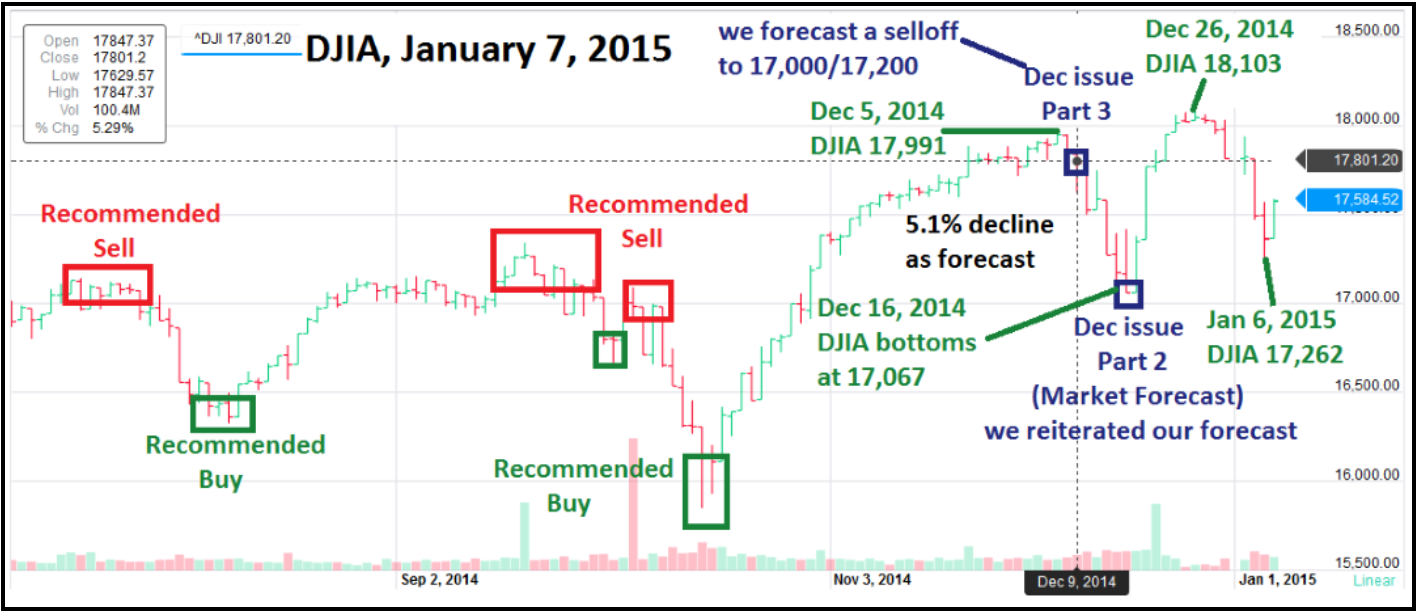 Invest Intelligence When It Realy Matters
Invest Intelligence When It Realy Matters
Opening Statement from the January 2015 Intelligent Investor (Part 3)
Opening Statement from the January 2015 Intelligent Investor (Part 3)
First published on January 7, 2015 for subscribers to the Intelligent Investor
Over the past couple of months we have been advising readers to consider raising cash gradually via selective selling (selling on strength) as we approach the New Year.
Although our general recommendation was to raise cash via selective selling, we also discussed that we believed the US stock market had a good deal of upside remaining for 2014. In the November Market Forecast we attached a 75% chance of the Dow Jones reaching 17,800.
We also discussed that 18,000 was possible. We stressed that if the 18,000 region was reached investors should really be trimming aggressively if in fact they elected (or needed) to sell in order to raise cash to position the portfolio adequately for future opportunities as well as creating a better atmosphere for restful sleep through the holiday period.
We also reminded readers that prior to adapting to this risk management strategy, they must accept the very real possibility that they may be required to repurchase market indices or specific securities at a higher price in the future if in fact we determine that risk has been reduced sufficiently.
Finally, we also provided some generic assistance to readers who might own securities on the recommended list. We stated that as the global economy continues to weaken, Cyclicals and IT are expected to perform poorly during economic contractions, while Healthcare and Consumer Staples are expected to outperform.
This is precisely how things have played out thus far. The Healthcare sector continues to lead the way, followed by Consumer Staples. Cyclicals and IT have lost strength (note that Utilities have been the top performer over the most recent month, but we do not cover this sector in this publication so we did not mention it. Dividend Gems includes several Utilities on the Recommended List).
As we had forecast, within two weeks of the November Market Forecast, the Dow hit 17,800 and climbed higher. By early December the Dow stopped just shy of 18,000, then the stock market sold off as we expected.
As you will recall, in the November 2014 US Market Forecast, we discussed that this “volatility retracement” could result in a downside of around 3% to 4% in the stock market. When the Part 3 of the December 2014 issue was being written, the Dow had declined by 2.5% (down to 17,533 on December 10 since reaching its all-time high of 17,991 on December 5). We noted that this relatively small move would not qualify as a real selloff or typical retracement.
We pointed out that additional factors caused us to lower the downside to this retracement, but we did not see anything that would cause the retracement to exceed 6.0%. In short, we stood by our previous forecast and investment strategy.
As you will recall, we followed up with a more detailed analysis and forecast on December 14, 2014. After factoring in new variables, we offered as the (most likely) worst case scenario a selloff to 16,800 in the Dow which would represent a decline of 6%. We added that our highest probability forecast was a bottom in the Dow of 17,000 to 17,200.
As you can see from the chart, the Dow made an intraday low on December 16, 2014 of 17,067, then mounted a strong rally to set a brand new all-time high by December 26, 2014 of 18,103. As a result, the decline amounted to 5.1%, well within our worst-case scenario of 6% and almost exactly as we forecast (between 17,000 and 17,200). You cannot get more accurate than this.

Although we felt the market would rebound back up to recent highs, we advised investors to be very conservative when getting into this expected bottom because we wanted to remain focused on raising cash. Hopefully, investors used this strength to selectively raise cash.
Going forward...
.png)